Voronoi Diagrams for Senior-Friendly Cities
Abstract
1. Introduction
2. Literature Review
2.1. Active Aging Determinants and Active Aging Places (AAP)
- Determinants related to health and social services systems (health promotion and disease prevention, curative services, long-term care, mental health services);
- Behavioral determinants (healthy living, such as engagement in physical activity, healthy eating, oral health, appropriate medication use, and avoidance of smoking and excessive alcohol intake);
- Determinants related to personal characteristics (biological, genetic, and psychological factors);
- Determinants related to the physical environment (living in safe environments, safe housing, few environmental hazards, and environmental cleanliness);
- Determinants related to the social environment (sufficient social support, education and literacy, and freedom from violence and abuse);
- Determinants related to economic conditions (sufficient income, social protection, and opportunities for dignified work).
2.2. Active Aging Determinants and Active Aging Places (AAP)
3. Materials and Methods
3.1. Study Area—Country and City
3.2. Preparation of the Survey Questionnaire
4. Results
4.1. Questionnaire Survey
4.2. Spatial Analysis with Voronoi Diagrams
5. Discussion
6. Conclusions
Author Contributions
Funding
Institutional Review Board Statement
Informed Consent Statement
Data Availability Statement
Conflicts of Interest
References
- Miszczak, E. Starość i Starzenie Się Społeczeństw — Przyczyny, Uwarunkowania Oraz Prognozy Na Przyszłość [Ageing and Population Ageing—Causes, Determinants and Future Prospects]. Eduk. Etyczna Ethical Educ. 2015, 9, 5–16. [Google Scholar]
- World Bank Population Aged 65 and Above. Available online: https://data.worldbank.org/indicator/SP.POP.65UP.TO (accessed on 14 October 2021).
- World Bank Population. Available online: https://data.worldbank.org/indicator/SP.POP.TOTL (accessed on 14 October 2021).
- Lui, C.-W.; Everingham, J.-A.; Warburton, J.; Cuthill, M.; Bartlett, H. What Makes a Community Age-Friendly: A Review of International Literature. Australas. J. Ageing 2009, 28, 116–121. [Google Scholar] [CrossRef] [PubMed]
- Global Age-Friendly Cities: A Guide; World Health Organization: Geneva, Switzerland, 2007.
- United Cities and Local Governments Global Charter—Agenda for Human Rights in the City. 2012. Available online: https://www.uclg-cisdp.org/sites/default/files/UCLG_Global_Charter_Agenda_HR_City_0.pdf (accessed on 14 October 2021).
- Desa, U.N. United Nations Transforming Our World: The 2030 Agenda for Sustainable Development. In Proceedings of the Resolution A/RES/70/1, UE Sustainable Development Agenda, New York, NY, USA, 25–27 September 2015. [Google Scholar]
- ISO 37120; Sustainable Development in Communities: Indicators for City Services and Quality of Life 2018. International Organization for Standardization: Geneva, Switzerland, 2018.
- Active Ageing: A Policy Framework, No. WHO/NMH/NPH/02.8; World Health Organization: Geneva, Switzerland, 2002.
- Regulski, J. Władze Miasta a Wymogi Polityki Urbanistycznej [City Councils and Urban Planning Policy Requirements]. In Miasto I Jego Władze. Studia Nad Ekonomiczną Teorią Rozwoju Miast [Town and City Authorities. Studies on the Economic Theory of Urban Development]; Regulski, J., Ed.; PWN: Warsaw, Poland, 1984; ISBN 830401761X. [Google Scholar]
- Giordano, K. Planowanie Zrównoważonego Rozwoju Gminy W Praktyce [Planning for Sustainable Municipal Development in Practice]; Wydawnictwo Katolickiego Uniwersytetu Lubelskiego: Lublin, Poland, 2005; ISBN 8373633219. [Google Scholar]
- Kudłacz, M.; Mazur-Kurach, P. Formy Zarządzania Publicznego W Rozwoju Miast w Polsce [Forms of Public Management in the Context of Urban Development in Poland]. Zarządzanie Publiczne Public Gov. 2015, 34, 2015. [Google Scholar] [CrossRef]
- Kohon, J. Social Inclusion in the Sustainable Neighborhood? Idealism of Urban Social Sustainability Theory Complicated by Realities of Community Planning Practice. City Cult. Soc. 2018, 15, 14–22. [Google Scholar] [CrossRef]
- Dawidowicz, A.; Zysk, E.; Figurska, M.; Źróbek, S.; Kotnarowska, M. The Methodology of Identifying Active Aging Places in the City—Practical Application. Cities 2020, 98, 102575. [Google Scholar] [CrossRef]
- Brown, G.; Weber, D. Measuring Change in Place Values Using Public Participation GIS (PPGIS). Appl. Geogr. 2012, 34, 316–324. [Google Scholar] [CrossRef]
- Jelokhani-Niaraki, M.; Hajiloo, F.; Samany, N.N. A Web-Based Public Participation GIS for Assessing the Age-Friendliness of Cities: A Case Study in Tehran, Iran. Cities 2019, 95, 102471. [Google Scholar] [CrossRef]
- Romshoo, S.A.; Amin, M.; Sastry, K.L.N.; Parmar, M. Integration of Social, Economic and Environmental Factors in GIS for Land Degradation Vulnerability Assessment in the Pir Panjal Himalaya, Kashmir, India. Appl. Geogr. 2020, 125, 102307. [Google Scholar] [CrossRef]
- Figurska, M. Zastosowanie Metod Teselacji W Analizach Geoprzestrzennych Rynku Nieruchomości [Application of Tessellation Methods in Geospatial Analyses of the Real Estate Market]. Ph.D. Thesis, University of Warmia and Mazury in Olsztyn, Olsztyn, Poland, 2019. [Google Scholar]
- Ai, T.; Yu, W.; He, Y. Generation of Constrained Network Voronoi Diagram Using Linear Tessellation and Expansion Method. Comput. Environ. Urban Syst. 2015, 51, 83–96. [Google Scholar] [CrossRef]
- Hillier, B.; Hanson, J. The Problem of Space. In The Social Logic of Space; Hillier, B., Hanson, J., Eds.; Cambridge University Press: Cambridge, UK, 1984; pp. 26–51. ISBN 1139935682. [Google Scholar]
- Szarota, Z. Demograficzny Obraz Polskiej Starości [Demographic Image of Polish Ageing]. Available online: http://www.utw.up.krakow.pl/pliki/lectorium/wyklad1.pdf (accessed on 28 November 2021).
- Walker, A. Commentary: The Emergence and Application of Active Aging in Europe. J. Aging Soc. Policy 2008, 21, 75–93. [Google Scholar] [CrossRef]
- Sykes, K.E.; Robinson, K.N. Making the Right Moves: Promoting Smart Growth and Active Aging in Communities. J. Aging Soc. Policy 2014, 26, 166–180. [Google Scholar] [CrossRef]
- Bauman, A.; Merom, D.; Bull, F.C.; Buchner, D.M.; Fiatarone Singh, M.A. Updating the Evidence for Physical Activity: Summative Reviews of the Epidemiological Evidence, Prevalence, and Interventions to Promote “Active Aging”. Gerontologist 2016, 56, S268–S280. [Google Scholar] [CrossRef] [PubMed]
- Yung, E.H.K.; Conejos, S.; Chan, E.H.W. Social Needs of the Elderly and Active Aging in Public Open Spaces in Urban Renewal. Cities 2016, 52, 114–122. [Google Scholar] [CrossRef]
- Lak, A.; Rashidghalam, P.; Myint, P.K.; Baradaran, H.R. Comprehensive 5P Framework for Active Aging Using the Ecological Approach: An Iterative Systematic Review. BMC Public Health 2020, 20, 33. [Google Scholar] [CrossRef]
- Lai, M.-M.; Lein, S.-Y.; Lau, S.-H.; Lai, M.-L. Modeling Age-Friendly Environment, Active Aging, and Social Connectedness in an Emerging Asian Economy. J. Aging Res. 2016, 2016, 2052380. [Google Scholar] [CrossRef] [PubMed]
- Holt, A.; Lee, A.H.; Jancey, J.; Kerr, D.; Howat, P. Are Retirement Villages Promoting Active Aging? J. Aging Phys. Act. 2016, 24, 407–411. [Google Scholar] [CrossRef]
- Chen, N.; Chen, J.; Ko, P. Active Aging in the Countryside: Space, Place and the Performance of Leisure—Work Lifestyles in Contemporary Rural China. Popul. Space Place 2021, 27, e2429. [Google Scholar] [CrossRef]
- Woods, J.A.; Hutchinson, N.T.; Powers, S.K.; Roberts, W.O.; Gomez-Cabrera, M.C.; Radak, Z.; Berkes, I.; Boros, A.; Boldogh, I.; Leeuwenburgh, C.; et al. The COVID-19 Pandemic and Physical Activity. Sports Med. Health Sci. 2020, 2, 55–64. [Google Scholar] [CrossRef]
- Rantanen, T.; Eronen, J.; Kauppinen, M.; Kokko, K.; Sanaslahti, S.; Kajan, N.; Portegijs, E. Life-Space Mobility and Active Aging as Factors Underlying Quality of Life among Older People before and during COVID-19 Lockdown in Finland—A Longitudinal Study. J. Gerontol. Ser. A 2021, 76, e60–e67. [Google Scholar] [CrossRef]
- Portegijs, E.; Saajanaho, M.; Leppä, H.; Koivunen, K.; Eronen, J.; Rantanen, T. Impact of Mobility Restrictions on Active Aging; Cross-Sectional Associations and Longitudinal Changes Parallel to COVID-19 Restrictions. Arch. Gerontol. Geriatr. 2022, 98, 104522. [Google Scholar] [CrossRef]
- Fernández-Ballesteros, R. Active Aging: The Contribution of Psychology; Hogrefe Publishing: Göttingen, Germany, 2008; ISBN 1616763604. [Google Scholar]
- da Silva, W.A.A.; Barbosa, K.T.F.; de Oliveira, F.M.R.L.; de Brito, F.M.; de Lyra Ramos, S.S.N.; Fernandes, A.M.; de Oliveira, S.M.; de Lacerda, H.J.M.; Soares, L.C.; Nunes, T.B.; et al. Personal and Behavioral Determinants of Active Aging. Int. Arch. Med. 2016, 9, 1–10. [Google Scholar] [CrossRef]
- Bełej, M.; Figurska, M. 3D Modeling of Discontinuity in the Spatial Distribution of Apartment Prices Using Voronoi Diagrams. Remote Sens. 2020, 12, 229. [Google Scholar] [CrossRef]
- Gold, C. Tessellations in GIS: Part I—Putting It All Together. Geo-Spat. Inf. Sci. 2016, 19, 9–25. [Google Scholar] [CrossRef][Green Version]
- Ahmadi, M. Crime Mapping and Spatial Analysis. Master’s Thesis, International Institute for Geo-Information Science and Earth Observation, Enschede, The Netherlands, 2003. [Google Scholar]
- She, B.; Zhu, X.; Ye, X.; Guo, W.; Su, K.; Lee, J. Weighted Network Voronoi Diagrams for Local Spatial Analysis. Comput. Environ. Urban Syst. 2015, 52, 70–80. [Google Scholar] [CrossRef]
- de Melo, S.N.; Frank, R.; Brantingham, P. Voronoi Diagrams and Spatial Analysis of Crime. Prof. Geogr. 2017, 69, 579–590. [Google Scholar] [CrossRef]
- Okabe, A.; Boots, B.; Sugihara, K.; Chiu, S.N. Spatial Tessellations: Concepts and Applications of Voronoi Diagrams, with a Foreword by DG Kendall, 2nd ed.; John Wiley & Sons, Ltd.: Chichester, UK, 2000; ISBN 978-0-471-98635-5. [Google Scholar]
- Gold, C. Tessellations in GIS: Part II—Making Changes. Geo-Spat. Inf. Sci. 2016, 19, 157–167. [Google Scholar] [CrossRef]
- Dong, P. Generating and Updating Multiplicatively Weighted Voronoi Diagrams for Point, Line and Polygon Features in GIS. Comput. Geosci. 2008, 34, 411–421. [Google Scholar] [CrossRef]
- Mostafavi, M.A.; Beni, L.H.; Mallet, K.H. Geosimulation of Geographic Dynamics Based on Voronoi Diagram. In Transactions on Computational Science IX. Lecture Notes in Computer Science; Gavrilova, M.L., Tan, C.J.K., Anton, F., Eds.; Springer: Berlin/Heidelberg, Germany, 2010; Volume 6290, pp. 183–201. ISBN 978-3-642-16007-3. [Google Scholar]
- Mioc, D.; Anton, F.; Gold, C.; Moulin, B. Kinetic Line Voronoi Operations and Their Reversibility. In Transactions on Computational Science IX. Lecture Notes in Computer Science; Gavrilova, M.L., Tan, C.J.K., Anton, F., Eds.; Springer: Berlin/Heidelberg, Germany, 2010; Volume 6290, pp. 139–165. ISBN 978-3-642-16007-3. [Google Scholar]
- Siejka, M. Metodyka Weryfikacji Cech Rynkowych Wpływających Na Poziom Cen Transakcyjnych i Jej Zastosowanie w Procesie Scalenia Gruntów [Methodology Verification the Impact of Market Features on the Level of Transaction Prices and Its Application in Land Consolidation Process]. Acta Sci. Pol. Adm. Locorum 2017, 16, 35–48. [Google Scholar] [CrossRef]
- Kisiała, W.; Rudkiewicz, M. Zastosowanie Diagramu Woronoja w Badaniu Przestrzennych Wzorców Rozmieszczenia i Dostępności Sklepów Dyskontowych [Application of the Voronoi Diagram in Analysing of Spatial Patterns to the Distribution of Discount Stores and Access to Them]. Przegląd Geogr. Pol. Geogr. Rev. 2017, 89, 187–212. [Google Scholar] [CrossRef]
- Xu, P. Voronoi Cells, Probabilistic Bounds, and Hypothesis Testing in Mixed Integer Linear Models. IEEE Trans. Inf. Theory 2006, 52, 3122–3138. [Google Scholar] [CrossRef]
- dos Santos, N.P.; Escobar, I.P. Discrete Evaluation of Stokes’s Integral by Means of Voronoi and Delaunay Structures. J. Geod. 2004, 78, 354–367. [Google Scholar] [CrossRef]
- Fujii, H.; Sugihara, K. Properties and an Approximation Algorithm of Round-Tour Voronoi Diagrams. In Transactions on Computational Science IX. Lecture Notes in Computer Science; Gavrilova, M.L., Tan, C.J.L., Anton, F., Eds.; Springer: Berlin/Heidelberg, Germany, 2010; Volume 6290, pp. 109–122. ISBN 978-3-642-16007-3. [Google Scholar]
- Longley, P.A.; Goodchild, M.F.; Maguire, D.J.; Rhind, D.W. Geographic Information Systems and Science, 2nd ed.; John Wiley & Sons: Chichester, UK, 2005; ISBN 0470870001. [Google Scholar]
- Boots, B. Spatial Tessellations. In Geographical Information Systems; Longley, P.A., Goodchild, M.F., Maguire, D.J., Rhind, D.W., Eds.; John Wiley & Sons, Inc.: Chichester, UK, 2005; pp. 503–526. [Google Scholar]
- Honiden, S.; Houle, M.E.; Sommer, C.; Wolff, M. Approximate Shortest Path Queries Using Voronoi Duals. In Transactions on Computational Science IX. Lecture Notes in Computer Science; Gavrilova, M.L., Tan, C.J.K., Anton, F., Eds.; Springer: Berlin/Heidelberg, Germany, 2010; Volume 6290, pp. 28–53. ISBN 978-3-642-16007-3. [Google Scholar]
- le Ber, F.; Lavigne, C.; Adamczyk, K.; Angevin, F.; Colbach, N.; Mari, J.-F.; Monod, H. Neutral Modelling of Agricultural Landscapes by Tessellation Methods—Application for Gene Flow Simulation. Ecol. Model. 2009, 220, 3536–3545. [Google Scholar] [CrossRef]
- Barrett, T.M. Voronoi Tessellation Methods to Delineate Harvest Units for Spatial Forest Planning. Can. J. For. Res. 1997, 27, 903–910. [Google Scholar] [CrossRef]
- Icke, V.; van de Weygaert, R. Fragmenting the Universe. Astron. Astrophys. 1987, 184, 16–32. [Google Scholar]
- Cua, G.B. Creating the Virtual Seismologist: Developments in Ground Motion Characterization and Seismic Early Warning. Ph.D. Thesis, California Institute of Technology, Pasadena, CA, USA, 2004. [Google Scholar]
- Cua, G.; Heaton, T. The Virtual Seismologist (VS) Method: A Bayesian Approach to Earthquake Early Warning. In Earthquake Early Warning Systems; Gasparini, P., Manfredi, G., Zschau, J., Eds.; Springer: Berlin/Heidelberg, Germany, 2007; pp. 97–132. ISBN 978-3-540-72241-0. [Google Scholar]
- Grasso, V.F.; Beck, J.L.; Manfredi, G. Seismic Early Warning Systems: Procedure for Automated Decision Making. In Earthquake Early Warning Systems; Gasparini, P., Manfredi, G., Zschau, J., Eds.; Springer: Berlin/Heidelberg, Germany, 2007; pp. 179–209. ISBN 978-3-540-72241-0. [Google Scholar]
- Iervolino, I.; Convertito, V.; Giorgio, M.; Manfredi, G.; Zollo, A. The Crywolf Issue in Earthquake Early Warning Applications for the Campania Region. In Earthquake Early Warning Systems; Gasparini, P., Manfredi, G., Zschau, J., Eds.; Springer: Berlin/Heidelberg, Germany, 2007; pp. 211–232. ISBN 978-3-540-72241-0. [Google Scholar]
- Satriano, C.; Lomax, A.; Zollo, A. Optimal, Real-Time Earthquake Location for Early Warning. In Earthquake Early Warning Systems; Gasparini, P., Manfredi, G., Zschau, J., Eds.; Springer: Berlin/Heidelberg, Germany, 2007; pp. 85–96. ISBN 978-3-540-72241-0. [Google Scholar]
- Schoenberg, F.P.; Barr, C.; Seo, J. The Distribution of Voronoi Cells Generated by Southern California Earthquake Epicenters. Env. Off. J. Int. Env. Soc. 2009, 20, 159–171. [Google Scholar] [CrossRef][Green Version]
- Bac-Bronowicz, J.; Borkowski, A. O Możliwościach Określenia Wielowariantowego Pola Podstawowego Dla Wartości Opadu Atmosferycznego [Possibilities of Determination of Values of Median Rainfall in Multi-Variant Reference Unit]. Arch. Fotogram. Kartogr. I Teledetekcji Arch. Photogramm. Cartogr. Remote Sens. 2003, 13, 21–32. [Google Scholar]
- Alhaddad, B.I.; Burns, M.C.; Roca, J. Methods for Monitoring the Detection of Multi-Temporal Land Use Change through the Classification of Urban Areas. In Proceedings of the International Archives of the Photogrammetry, Remote Sensing and Spatial Information Sciences, UDMS 2011: 28th Urban Data Management Symposium, Delft, The Netherlands, 28–30 September 2011; Volume XXXVIII-4/C21. [Google Scholar]
- Gazi, A.; Korkmaz, K. Design Method for Radially Retractable Single DOF Plate Structure Based on Regular 1-Uniform Regular Tessellations. Megaron 2015, 10, 317–331. [Google Scholar] [CrossRef]
- Laurini, R.; Thompson, D. Fundamentals of Spatial Information Systems; The APIC Series, No. 37; Academic Press: San Diego, CA, USA, 1992; Volume 37, ISBN 0124383807. [Google Scholar]
- Hangouët, J.-F.; Djadri, R. Voronoi Diagrams on Line Segments: Measurements for Contextual Generalization Purposes. In International Conference on Spatial Information Theory. Spatial Information Theory: A Theoretical Basic for GIS, Lecture Notes in Computer Science; Springer: Berlin/Heidelberg, Germany, 1997; pp. 207–222. [Google Scholar]
- Ren, J.; Dijksman, J.; Behringer, R.P. Homogeneity and Packing Structure of a 2D Sheared Granular System. In Proceedings of the AIP Conference Proceedings, No. 527, University Park, MD, USA, 18 June 2013; Volume 1542, pp. 527–530. [Google Scholar]
- Batista, M.R.; Calvo, R.; Romero, R.A.F. A Robot On-Line Area Coverage Approach Based on the Probabilistic Lloyd Method. In Proceedings of the 2013 International Joint Conference on Neural Networks (IJCNN), Dallas, TX, USA, 4 August 2013; pp. 2145–2152. [Google Scholar]
- Peterka, T.; Kwan, J.; Pope, A.; Finkel, H.; Heitmann, K.; Habib, S.; Wang, J.; Zagaris, G. Meshing the Universe: Integrating Analysis in Cosmological Simulations. In Proceedings of the SC Companion: High Performance Computing, Networking Storage and Analysis (SCC), Salt Lake City, UT, USA, 10 November 2012; pp. 186–195. [Google Scholar]
- Andronov, L.; Orlov, I.; Lutz, Y.; Vonesch, J.-L.; Klaholz, B.P. ClusterViSu, a Method for Clustering of Protein Complexes by Voronoi Tessellation in Super-Resolution Microscopy. Sci. Rep. 2016, 6, 24084. [Google Scholar] [CrossRef]
- Rożniatowski, K.; Kosmulski, M. Advanced Analysis of SEM Images of Carbon-Ceramic Composites. Adsorpt. Sci. Technol. 2007, 25, 473–478. [Google Scholar] [CrossRef]
- Figurska, M.; Bełej, M. Teselacja Jako Metoda Badania Aktywności Rynku Mieszkaniowego [Tessellation as a Method of Studying the Activity of a Residential Real Estate Market]. Biul. Stowarzyszenia Rzeczozn. Majątkowych Województwa Wielkop. Bull. Soc. Real Estate Valuers Wielkop. Voiv. 2018, 50, 18–28. [Google Scholar]
- Ahuja, N.; Tuceryan, M. Extraction of Early Perceptual Structure in Dot Patterns: Integrating Region, Boundary, and Component Gestalt. Comput. Vis. Graph. Image Processing 1989, 48, 304–356. [Google Scholar] [CrossRef]
- Ningsheng, T.; Chongjun, Y.; LiuZhong, Y.; Yuan, L. An Address Regional Tessellation Method for Spatial Subdivision and Geocoding in Digital Earth System. Int. J. Digit. Earth 2015, 8, 825–839. [Google Scholar] [CrossRef]
- Jancz, A.; Trojanek, R. Housing Preferences of Seniors and Pre-Senior Citizens in Poland—A Case Study. Sustainability 2020, 12, 4599. [Google Scholar] [CrossRef]
- Demographic Yearbook of Poland; Statistics Poland: Warsaw, Poland, 2021.
- Eurostat Statistics—Poland. 2016. Available online: https://ec.europa.eu/eurostat/databrowser/view/tps00001/default/table?lang=en (accessed on 14 October 2021).
- Global Strategy and Action Plan on Ageing and Health and New WHO Framework for Engagement with Non-State Actors; World Health Organization: Geneva, Switzerland, 2016.
- 10 Priorities towards a Decade of Healthy Ageing; World Health Organization: Geneva, Switzerland, 2017.
- Ageing and Health; World Health Organization: Geneva, Switzerland, 2018.
- Lee, E.; Dean, J. Perceptions of Walkability and Determinants of Walking Behaviour among Urban Seniors in Toronto, Canada. J. Transp. Health 2018, 9, 309–320. [Google Scholar] [CrossRef]
- Bertocchi, G.; Brunetti, M.; Torricelli, C. Marriage and Other Risky Assets: A Portfolio Approach. J. Bank. Financ. 2011, 35, 2902–2915. [Google Scholar] [CrossRef]
- Cocco, J.F.; Gomes, F.J.; Maenhout, P.J. Consumption and Portfolio Choice over the Life Cycle. Rev. Financ. Stud. 2005, 18, 491–533. [Google Scholar] [CrossRef]
- Yogo, M. Portfolio Choice in Retirement: Health Risk and the Demand for Annuities, Housing, and Risky Assets. J. Monet. Econ. 2016, 80, 17–34. [Google Scholar] [CrossRef]
- Nakajima, M.; Telyukova, I.A. Housing and Saving in Retirement across Countries. In Contemporary Issues in Microeconomics; Stiglitz, J.E., Guzman, M., Eds.; Springer: London, UK, 2016; pp. 88–126. [Google Scholar]
- Angelini, V.; Brugiavini, A.; Weber, G. The Dynamics of Homeownership among the 50+ in Europe. J. Popul. Econ. 2014, 27, 797–823. [Google Scholar] [CrossRef]
- Frumkin, H. Healthy Places: Exploring the Evidence. Am. J. Public Health 2003, 93, 1451–1456. [Google Scholar] [CrossRef]
- Kerr, J.; Rosenberg, D.; Frank, L. The Role of the Built Environment in Healthy Aging: Community Design, Physical Activity, and Health among Older Adults. J. Plan. Lit. 2012, 27, 43–60. [Google Scholar] [CrossRef]
- European Parliament Resolution of on Demographic Future of Europe (EU) 2008, 2007/2156(INI). In Proceedings of the Demographic Future of Europe, Strasbourg, France, 21 February 2008.
- Budżety Gospodarstw Domowych w 2020 r. [Household Budget Surveys in 2021]. Informacje Statystyczne [Statistical Information]; Główny Urząd Statystyczny [Statistics Poland]: Warsaw, Poland, 2021.
- Stan i Struktura Oraz Ruch Naturalny w Przekroju Terytorialnym w 2021 r. Stan w Dniu 30 Czerwca. Informacje Statystyczne [Population. Size and Structure and Vital Statistics in Poland by Territorial Division in 2021. As of 30th June. Statistical Information]; Główny Urząd Statystyczny [Statistics Poland] Ludność: Warsaw, Poland, 2021.
- Sytuacja Gospodarstw Domowych w 2020 r. w Świetle Wyników Badań Budżetów Gospodarstw Domowych. Informacja Sygnalna, Wyniki Badań GUS [The Situation of Households in 2020 on the Basis of Results of the Household Budget Survey. News Release, GUS Survey Results]; Główny Urząd Statystyczny [Statistics Poland]: Warsaw, Poland, 2021.
- Struktura Narodowo-Etniczna, Językowa i Wyznaniowa Ludności Polski. Narodowy Spis Powszechny Ludności i Mieszkań 2011 [National-Ethnic, Linguistic and Religious Structure of the Polish Population. National Population and Housing Census 2011]; Główny Urząd Statystyczny [Statistics Poland]: Warsaw, Poland, 2015.
- Małżeństwa i Dzietność w Polsce 2015 [Marriage and Fertility in Poland 2015]; Główny Urząd Statystyczny [Statistics Poland]: Warsaw, Poland, 2016.
- Sytuacja Demograficzna Polski Do 2018 r. Tworzenie i Rozpad Rodzin [Demographic Situation in Poland up to 2018. Families Creation and Dissolution]; Główny Urząd Statystyczny [Statistics Poland]: Warsaw, Poland, 2019.
- Matejko, A. Potrzeby Mieszkaniowe Seniorów—Studium Przypadku Na Przykładzie Miasta Stołecznego Warszawa [Housing Needs of Seniors—Warsaw]. Engineer’s Thesis, University of Warmia and Mazury in Olsztyn, Olsztyn, Poland, 2019. [Google Scholar]
- Borowska, M. Potrzeby Mieszkaniowe Seniorów—Miasto Olsztyn [Analysis of Housing Senior’s Needs—Olsztyn City]. Engineer’s Thesis, University of Warmia and Mazury in Olsztyn, Olsztyn, Poland, 2019. [Google Scholar]
- Sytuacja Gospodarstw Domowych w 2015 r. w Świetle Wyników Badań Budżetów Gospodarstw Domowych. Informacja Sygnalna, Wyniki Badań GUS [The Situation of Households in 2015 on the Basis of Results of the Household Budget Survey. News Release, GUS Survey Results]; Główny Urząd Statystyczny [Statistics Poland]: Warsaw, Poland, 2016.
- Sytuacja Demograficzna Osób Starszych i Konsekwencje Starzenia Się Ludności Polski w Świetle Prognozy Na Lata 2014–2050 [The Demographic Situation of the Elderly and the Consequences of Population Ageing in Poland in the Light of the Projections for 2014–2050]; Główny Urząd Statystyczny [Statistics Poland]: Warsaw, Poland, 2014.
- Jak Się Żyje Osobom Starszym w Polsce? [How Older People Live in Poland?]; Główny Urząd Statystyczny [Statistics Poland]: Warsaw, Poland, 2012.
- Instytut Pracy i Spraw Socjalnych [Institute of Labour and Social Studies]. Badanie Ewaluacyjne Realizacji Rządowego Programu Na Rzecz Aktywności Osób Starszych Na Lata 2014–2020 Edycje 2016–2019 [Evaluation Study on the Implementation of the Government Programme for Active Ageing 2014–2020 Editions 2016–2019]. 2020. Available online: https://das.mpips.gov.pl/source/2020/Badanie%20ewaluacyjne%20realizacji%20Rzdowego%20Programu%20na%20rzecz%20Aktywnosci%20Osob%20Starszych%20na%20lata%202014-2020%20Edycje%202016-2019.pdf (accessed on 15 October 2021).
- Błędowski, P.; Szatur-Jaworska, B.; Szweda-Lewandowska, Z.; Kubicki, P. Raport Na Temat Sytuacji Osób Starszych w Polsce [Report on the Situation of Older People in Poland]; Instytut Pracy i Spraw Socjalnych [Institute of Labour and Social Studies]: Warsaw, Poland, 2012. [Google Scholar]
- Wiles, J.L.; Allen, R.E.S.; Palmer, A.J.; Hayman, K.J.; Keeling, S.; Kerse, N. Older People and Their Social Spaces: A Study of Well-Being and Attachment to Place in Aotearoa New Zealand. Soc. Sci. Med. 2009, 68, 664–671. [Google Scholar] [CrossRef] [PubMed]
- Ramella, M.; Nonino, M.; Boschin, W.; Fadda, D. Cluster Identification via Voronoi Tessellation. In Proceedings of the Observational Cosmology: The Development of Galaxy Systems, Astronomical Society of the Pacific Conference Series; Giuricin, G., Mezetti, M., Salucci, P., Eds.; Astronomical Society of the Pacific: Orem, UT, USA, 1999; Volume 176, pp. 1–5. [Google Scholar]
- van Breukelen, C.; Clewley, L. A Reliable Cluster Detection Technique Using Photometric Redshifts: Introducing the 2TecX Algorithm. Mon. Not. R. Astron. Soc. 2009, 395, 1845–1856. [Google Scholar] [CrossRef][Green Version]
- Dashti, H.T.; Aghaeepour, N.; Asadi, S.; Bastani, M.; Delafkar, Z.; Disfani, F.M.; Ghaderi, S.M.; Kamali, S.; Pashami, S.; Siahpirani, A.F. Dynamic Positioning Based on Voronoi Cells (DPVC). In RoboCup 2005: Robot Soccer World Cup IX, Lecture Notes in Computer Science; Bredenfeld, A., Jacoff, A., Noda, I., Takahashi, Y., Eds.; Springer: Berlin/Heidelberg, Germany, 2005; Volume 4020, pp. 219–229. [Google Scholar]
- Yiu, M.L.; Mamoulis, N.; Karras, P. Common Influence Join: A Natural Join Operation for Spatial Pointsets. In Proceedings of the 2008 IEEE 24th International Conference on Data Engineering (ICDE), Cancun, Mexico, 12 April 2008; pp. 100–109. [Google Scholar]
- Bochenek, A.; Jasiński, T. Zastosowanie Algorytmu Woronoja Do Określenia Dostępności Terenów Zieleni w Wybranych, Dużych Miastach Europy [The Use of the Voronoi Algorithm to Determine the Accessibility of Green Areas in Selected Great European Cities]. Współczesne Probl. I Kierun. Badaw. W Geogr. Contemp. Probl. Res. Dir. Geogr. 2015, 3, 17–27. [Google Scholar]
- Adhinugraha, K.; Taniar, D.; Phan, T.; Beare, R. Predicting Travel Time within Catchment Area Using Time Travel Voronoi Diagram (TTVD) and Crowdsource Map Features. Inf. Processing Manag. 2022, 59, 102922. [Google Scholar] [CrossRef]
- Yang, H.; Zhang, S.; Liu, R.; Krall, A.; Wang, Y.; Ventura, M.; Deflitch, C. Epidemic Informatics and Control: A Holistic Approach from System Informatics to Epidemic Response and Risk Management in Public Health. In AI and Analytics for Public Health-Proceedings of the 2020 INFORMS International Conference on Service Science; Springer: Berlin/Heidelberg, Germany, 2021; pp. 1–46. [Google Scholar]
- Wang, Z.; Han, Q.; de Vries, B.; Dai, L. Insights into the Correspondence between Land Use Pattern and Spatial Distribution of Rail Transit Services. Appl. Spat. Anal. Policy 2021, 14, 907–928. [Google Scholar] [CrossRef]
- European Funds Program Dostępność Plus [Accessibility Plus Programme]. Available online: https://www.funduszeeuropejskie.gov.pl/strony/o-funduszach/fundusze-europejskie-bez-barier/dostepnosc-plus/ (accessed on 22 November 2021).
- Masuyama, A. Methods for Detecting Apparent Differences between Spatial Tessellations at Different Time Points. Int. J. Geogr. Inf. Sci. 2006, 20, 633–648. [Google Scholar] [CrossRef]
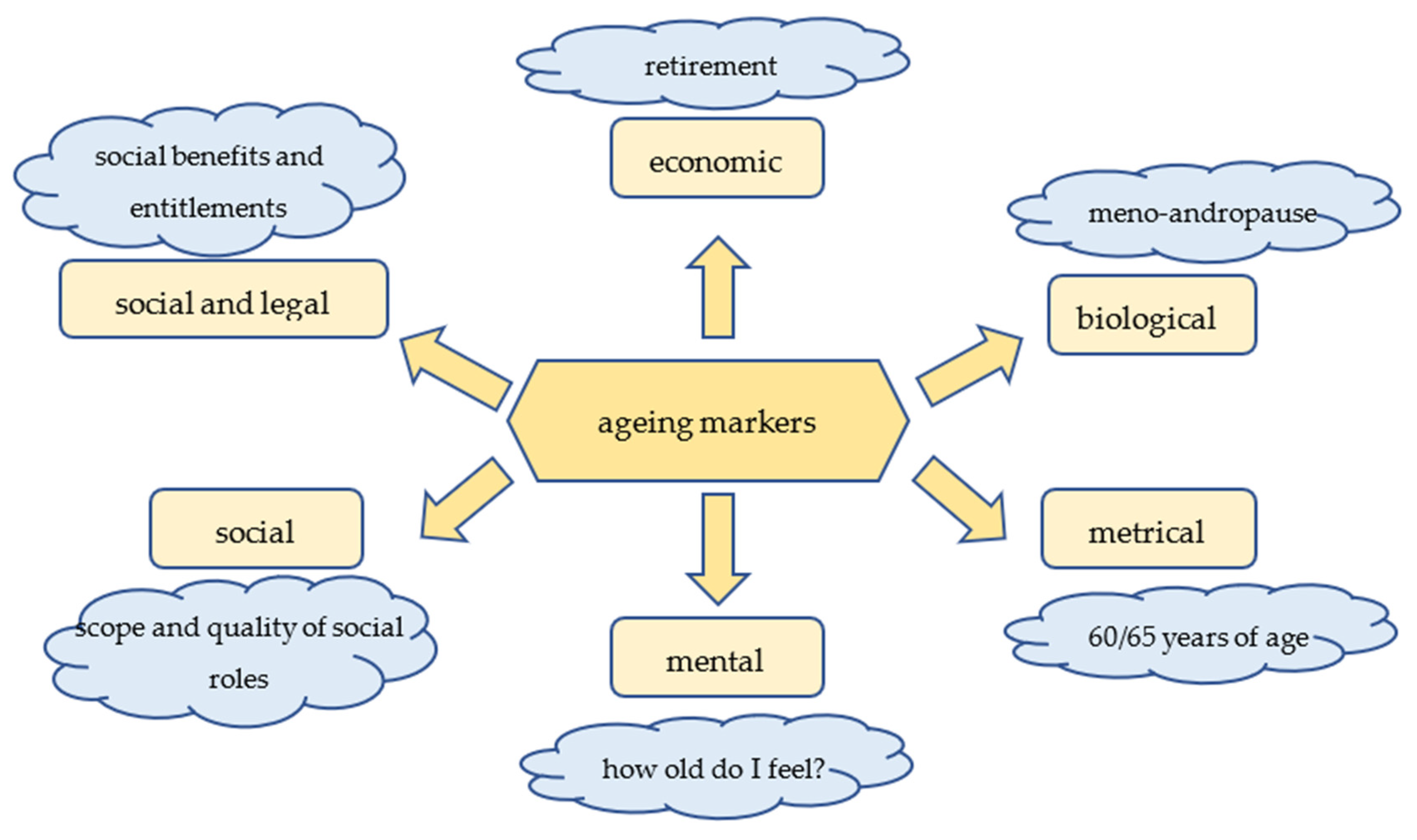
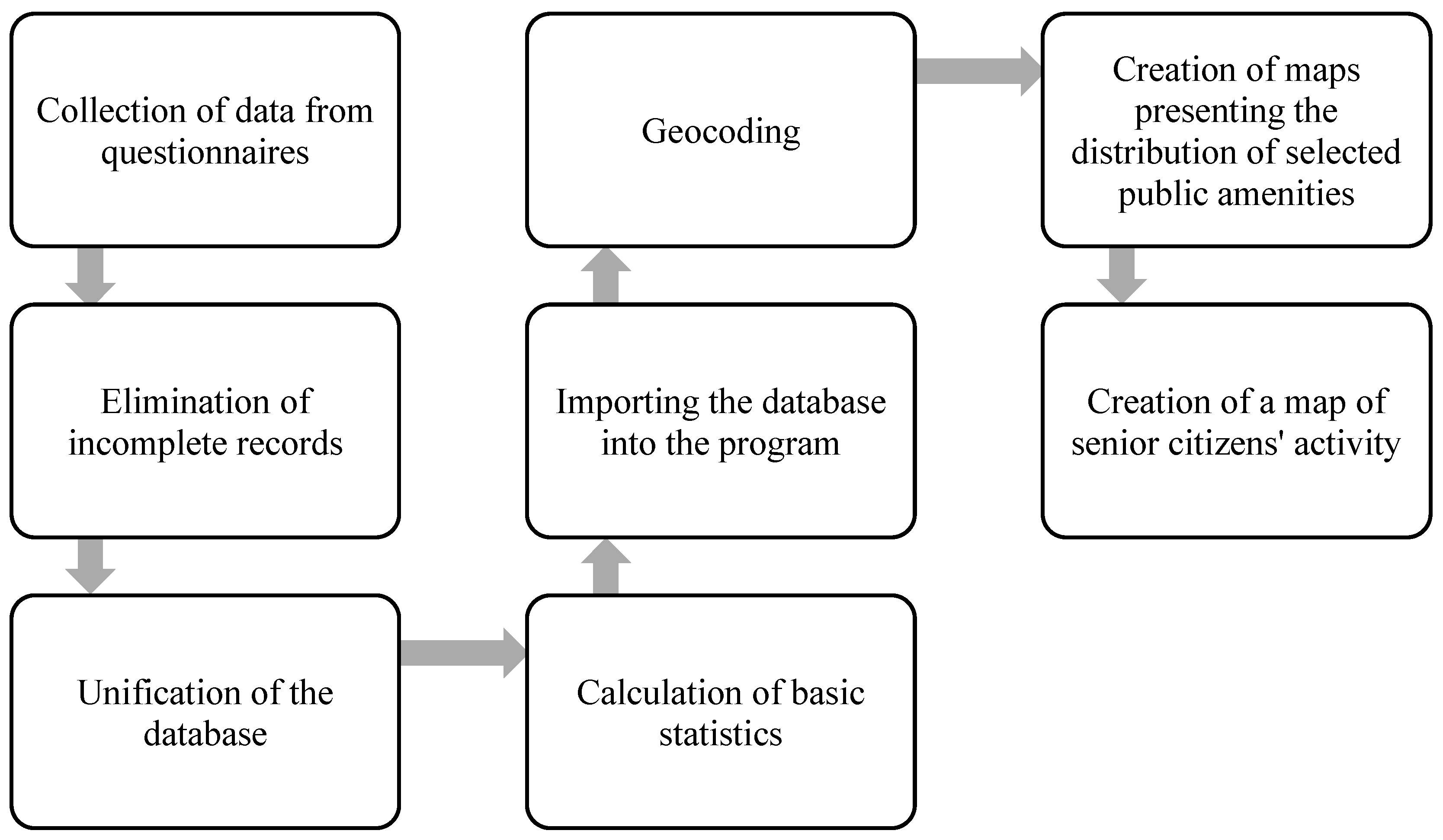

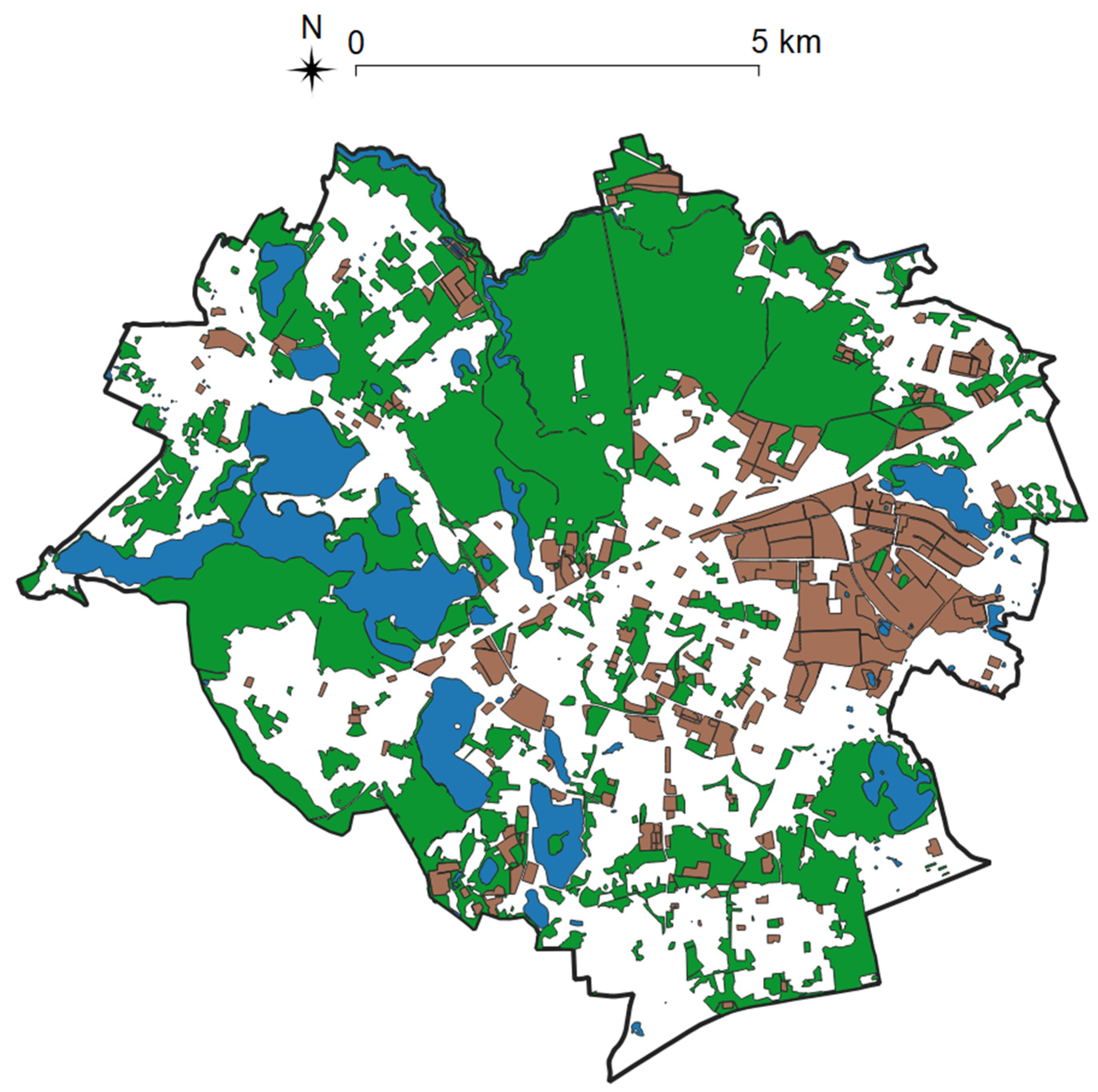
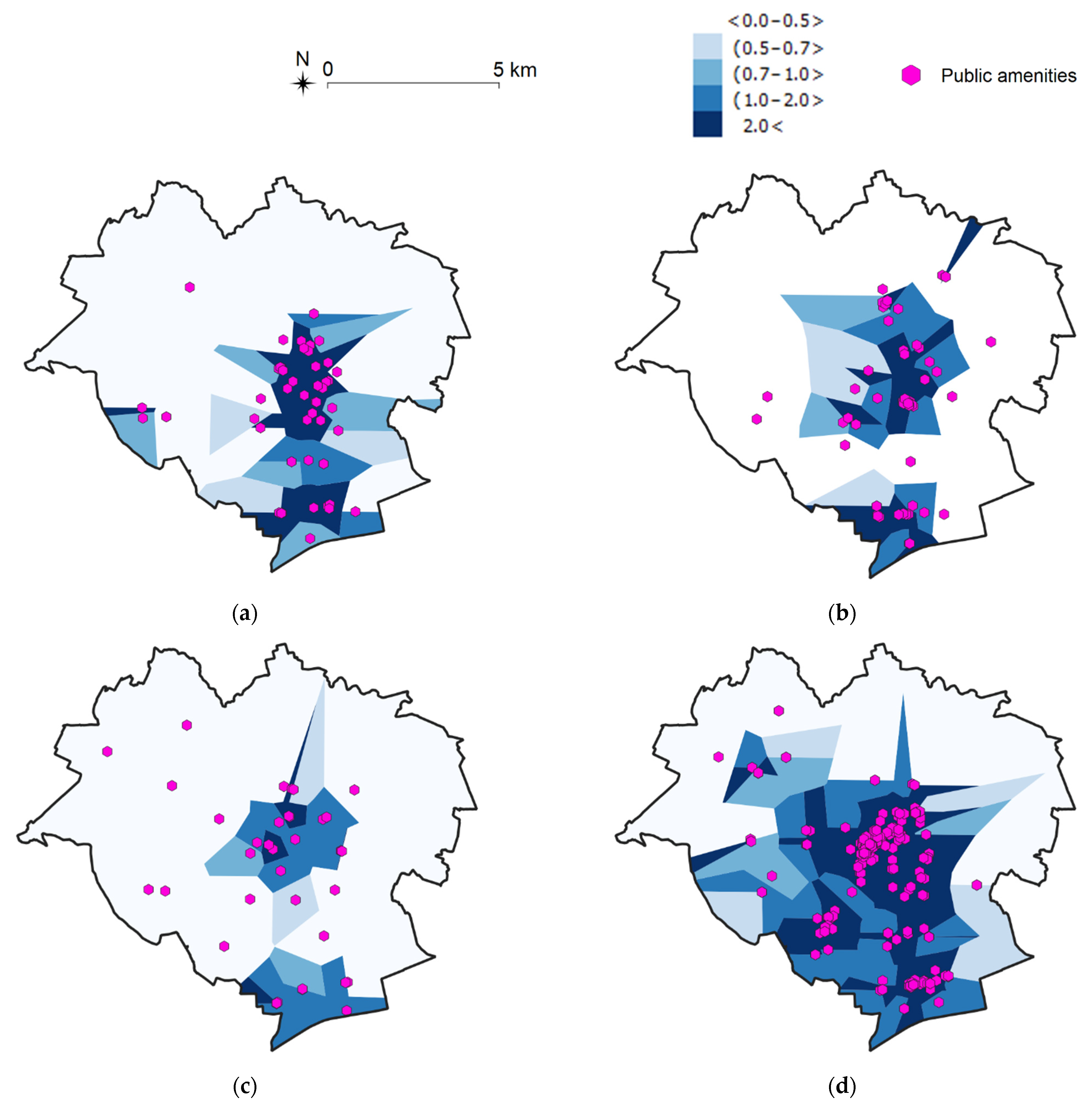
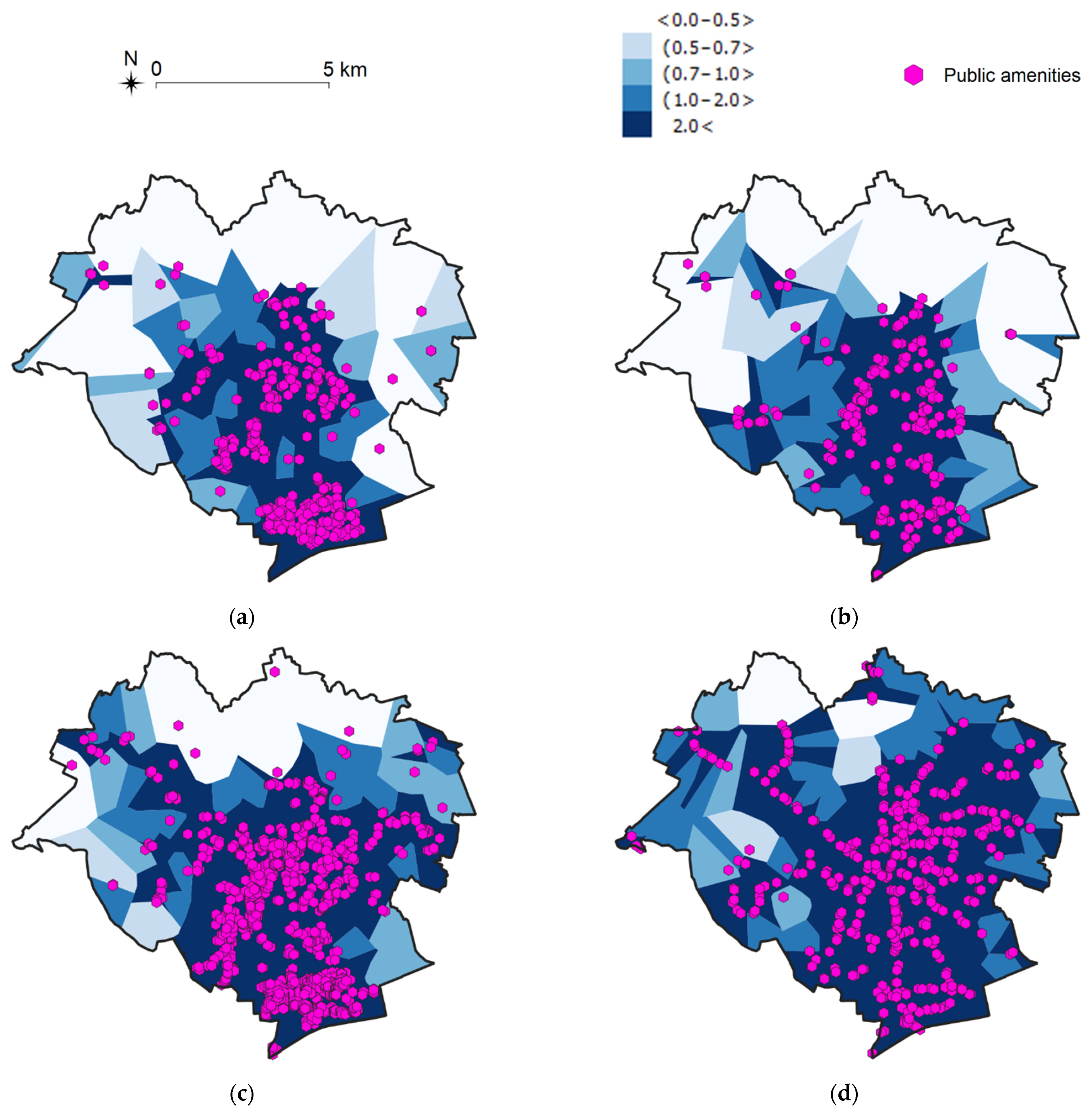
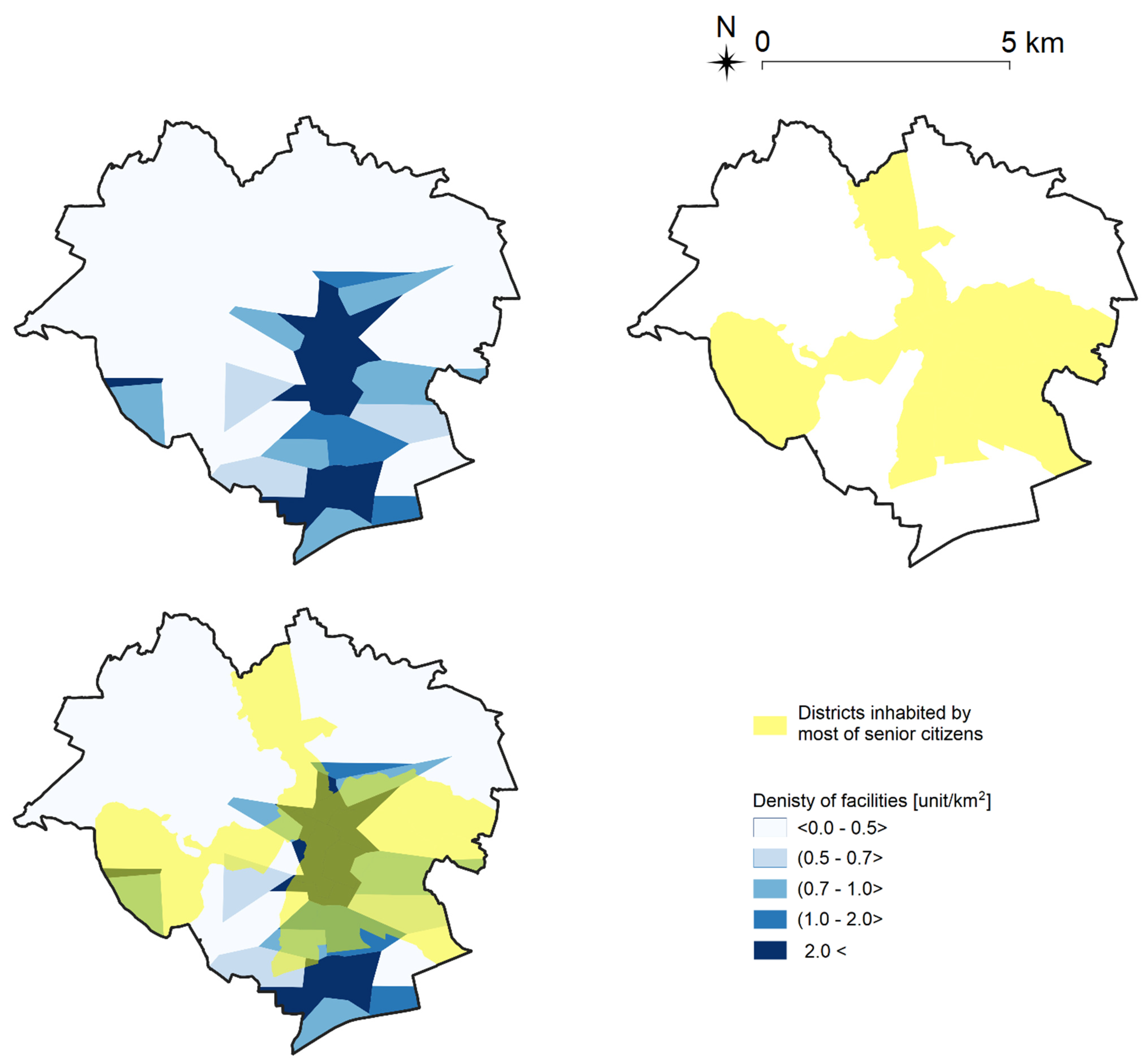
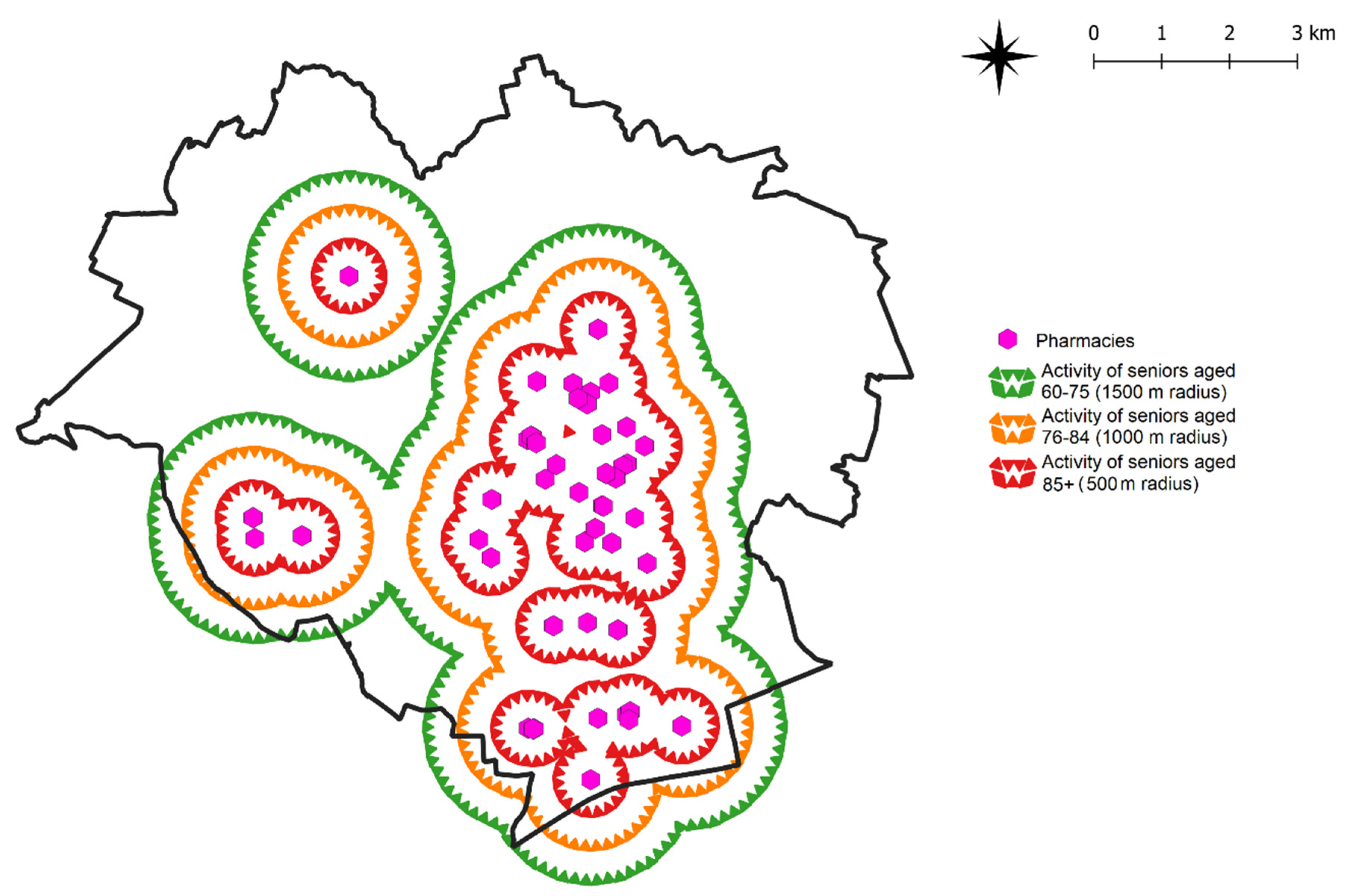

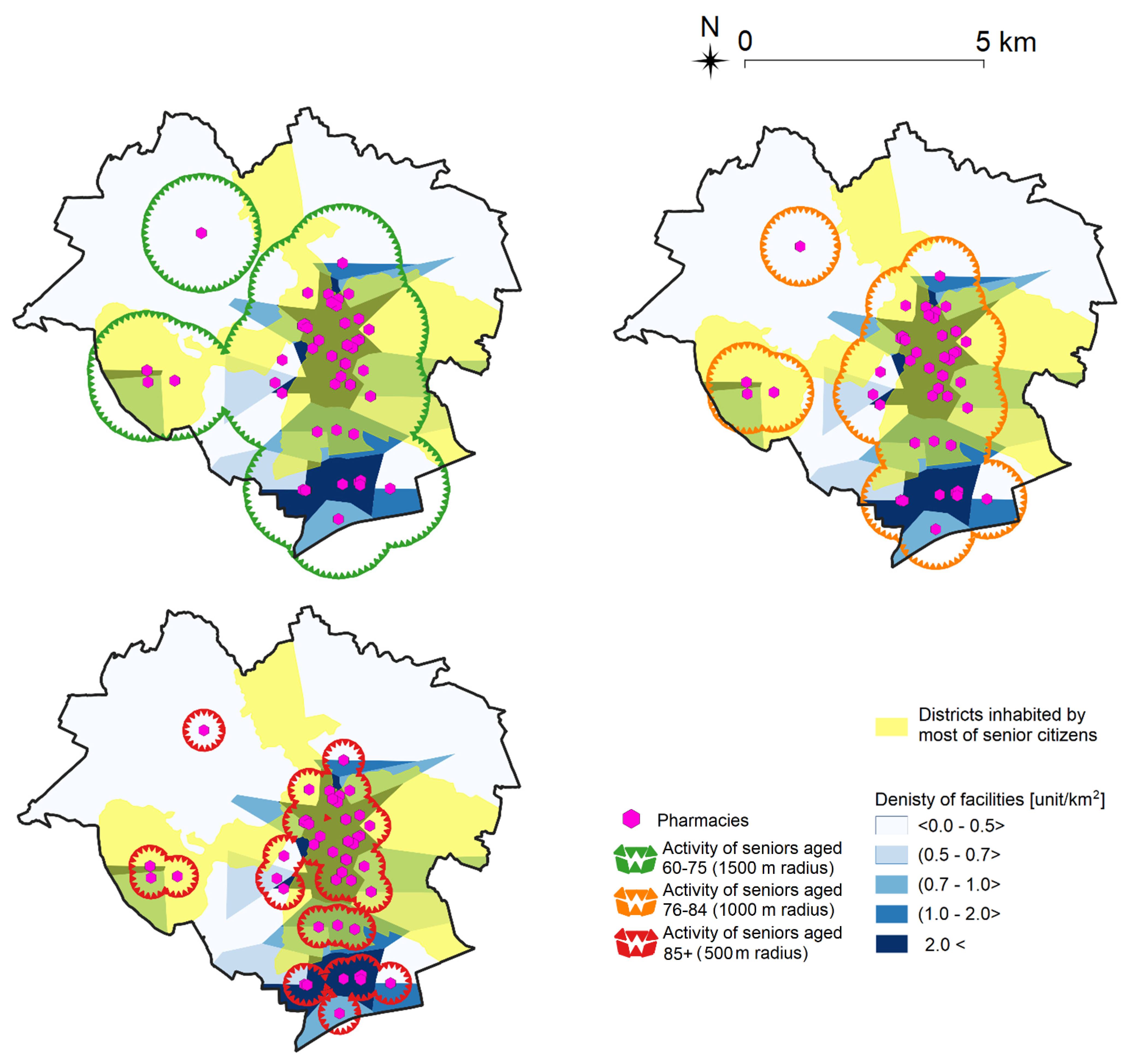

| Scientific Field | Use |
|---|---|
| Geodesy, geography, gravimetry |
|
| Forestry, agriculture | |
| Geology, seismology, hydrology |
| Structure of Older People | Years | Description |
|---|---|---|
| pre-old age | 55–59 | pre-senior |
| early old age | 60/65–74 | young old |
| old age proper | 75–89 | old-old |
| oldest-old | 90+ | oldest-old-lifelong |
| Demographic Data | Poland | Olsztyn |
|---|---|---|
| Population | 38,265,013 | 171,249 |
| Older people (aged 60 years and more) | 26% | 27% |
| Percentage of women among older people | 58% | 60% |
| Growth rate of the older population | ||
| 1990 (urban areas) 2020 (urban areas) | 10.2% 25.6% | 9.0% 27.2% |
| Old-age dependency ratio (number of persons of non-working age per 100 persons of working-age) | 46 | 47 |
| AGE STRUCTURE OF SENIORS IN CITIES WITH A POPULATION OF 100,000: | ||
| 55–59 60–75 76–84 85 and older | 10% 11% 4% 4% | 6% 20% 5% 2% |
| No. | Profile Categories | Description |
|---|---|---|
| 1 | Demographic profile | A set of data about a particular social group (senior citizens), including:
|
| 2 | Psychological profile | A set of data based on a demographic database and psychometrics, understood as a collection of data about senior citizens, focused on their life attitudes, aspirations, interests, lifestyles, etc. It provides a deeper and more subjective understanding of who senior citizens are and how they think. It covers issues such as:
problems and concerns. |
| 3 | Behavioral profile | A set of data building on the previous two profiles indicating the specific behavior of senior citizens under study. It sets the parameters for a positive or negative attitude towards the world and life, determining a space in which one feels comfortable. |
| 4 | Economic profile | A set of data identifying the financial capabilities (income) and expenditures carried out by households of senior citizens. |
| 5 | Profile of activity needs | A set of data identifying the needs of senior citizens in terms of their expectations from the space in which they live, spend their free time, and become active. |
| 6 | Profile of the proximate space | A set of data concerning the place of residence of senior citizens (their homes). |
| 7 | Profile of transitional space | A set of data concerning the surroundings of the place of residence of senior citizens (neighborhood they live in). |
| 8 | Profile of the future | A set of data about the possibility of relocation (moving to another place) by senior citizens. |
| Data | |
|---|---|
| Population age structure in households of senior citizens: | |
| 1.8% |
| 4.4% |
| 6.9% |
| 3.2% |
| 15.0% |
| 68.5% |
| Gender: | |
| 41.9% |
| 58.1% |
| Ethnic group: | |
| 96.8% |
| 4.4% |
| Marital status and number of children (fertility): | |
| 6.5% |
| 65.1% |
| 22.3% |
| 6.1% |
| Old age for men mostly means living with another person, and for women it is mostly being alone. | |
| Geographical location (voivodeship): | |
| 13.7% |
| 12.5% |
| 8.6% |
| 8.4% |
| 7.8% |
| 6.8% |
| 5.8% |
| 5.6% |
| 5.4% |
| 5.3% |
| 4.6% |
| 3.6% |
| 3.4% |
| 3.1% |
| 2.7% |
| 2.6% |
| Occupation: | |
| 16.4% |
| 6.3% |
| 3.1% |
| 56.6% |
| 6.9% |
| 1.5% |
| 7.8% |
| Education: | |
| 16.2% |
| 2.4% |
| 24.3% |
| 9.2% |
| 33.5% |
| 29.1% |
| 0.8% |
| 17.3% |
| 0.7% |
| Older people have on average a lower level of education than the younger generation. There remains a wide disparity in educational attainment between seniors living in urban and rural areas. | |
| Data | |
|---|---|
| Satisfaction with: | |
| 66.3% |
| 77.4% |
| 31.8% |
| 52.9% |
| 82.9% |
| 65.0% |
| 23.5% |
Senior citizens:
| |
| Data | |
|---|---|
| Active citizenship and voluntary activities: | |
| 40.5% |
| 9.8% |
| 5.7% |
| Relations with other people: | |
| 61.2% |
| 74.5% |
| 80.4% |
| Data | |
|---|---|
| Financial capabilities: | |
| 1940.87 |
| 1633.43 |
| 1335.94 |
| 20,685.00 |
| Evaluation of material situation: | |
| 17.6% |
| 22.6% |
| 51.7% |
| 6.7% |
| 1.4% |
| “Making ends meet”: | |
| 6.9% |
| 16.0% |
| 38.1% |
| 29.7% |
| 7.4% |
| 1.9% |
| Data | |
|---|---|
| Activities: | |
| 13.7% |
| 14.5% |
| 24.0% |
| 11.2% |
| 6.6% |
| 1.0% |
| 9.1% |
| 67.5% |
| 28.9% |
| 9.9% |
| 18.8% |
| 20.7% |
| 30.1% |
| 19.5% |
| 27.2% |
| 1.9% |
| 8.4% |
| 29.2% |
| 12.9% |
| 39.0% |
| 12.4% |
| 38.4% |
| 22.8% |
| Data | |
|---|---|
| Place of residence: | |
| 39.5% |
| 4.8% |
| 55.5% |
| 2.9 |
| Data |
|---|
Seniors appreciate where they live, mostly because of the possibilities for good communication within their towns. In addition, access to green space parks is extremely important to them (34%). In their surroundings seniors would like to:
|
| Data |
|---|
| 90% of seniors would not change their place of residence. |
| No. | Active Aging Groups | Active Aging Places | Significance of Active Aging Places in the Aging Structure | ||||
|---|---|---|---|---|---|---|---|
| Age | 55–59 | 60–75 | 76–84 | 85+ | |||
| 1 | Culture and science | Cinema | 1 | 1 | 0 | 0 | |
| Theatre | 0 | 1 | 0 | 0 | |||
| Museum/Gallery | 0 | 0 | 0 | 0 | |||
| Library | 2 | 2 | 2 | 1 | |||
| Further education sites (language courses, postgraduate studies) | 0 | 0 | 0 | 0 | |||
| Concerts/Festivals | 1 | 1 | 0 | 0 | |||
| Visiting relatives (family, friends, neighbours) | 3 | 3 | 2 | 2 | |||
| 2 | Physical activity/Sports | Swimming pool | 2 | 2 | 0 | 0 | |
| Gym | 0 | 0 | 0 | 0 | |||
| Nordic walking sites | 2 | 0 | 0 | 0 | |||
| Parks and squares/Walks | 3 | 3 | 0 | 0 | |||
| Cycle paths | 0 | 1 | 0 | 0 | |||
| 3 | Recreations | Travel agencies/Sightseeing tours | 0 | 1 | 0 | 0 | |
| Dancing clubs/Dancing events | 0 | 0 | 0 | 0 | |||
| Public sites for playing Chess/Cards | 0 | 0 | 0 | 0 | |||
| Cafés/Restaurants | 1 | 0 | 0 | 0 | |||
| Parks/Botanical gardens | 2 | 2 | 0 | 0 | |||
| Allotments gardens (garden work) | 2 | 2 | 0 | 0 | |||
| 4 | Health | Clinics and health centres | 2 | 0 | 2 | 2 | |
| Specialist healthcare centres | 2 | 0 | 2 | 2 | |||
| Hospitals | 0 | 0 | 0 | 0 | |||
| Sanatoria | 0 | 0 | 0 | 0 | |||
| Rehabilitation centres | 0 | 0 | 0 | 0 | |||
| 5 | Administration | Town hall | 1 | 1 | 0 | 0 | |
| Social welfare office | 0 | 0 | 0 | 1 | |||
| Property manager | 0 | 0 | 0 | 0 | |||
| Bank (paying the bills) | 0 | 1 | 2 | 0 | |||
| Post office | 1 | 1 | 2 | 0 | |||
| Police station | 0 | 0 | 0 | 0 | |||
| Tax office | 0 | 0 | 0 | 0 | |||
| Social Insurance Institution | 0 | 0 | 0 | 0 | |||
| 6 | Transport | Bus stops—Public transport | 3 | 0 | 1 | 0 | |
| Garage space/Own car | 3 | 2 | 0 | 0 | |||
| Cycling path | 0 | 0 | 0 | 0 | |||
| Taxi stands | 0 | 0 | 0 | 0 | |||
| 7 | Worship | Churches | 2 | 3 | 3 | 0 | |
| Other objects and places of worship | 0 | 0 | 0 | 0 | |||
| Cemeteries | 2 | 2 | 2 | 1 | |||
| 8 | Home activity | Home space | Watching TV | 3 | 3 | 3 | 3 |
| Reading | 3 | 3 | 3 | 0 | |||
| Cleaning | 3 | 3 | 3 | 1 | |||
| Entertaining | 3 | 3 | 3 | 3 | |||
| 9 | Shopping | Supermarkets | 3 | 3 | 0 | 0 | |
| Local groceries | 3 | 3 | 2 | 0 | |||
| Shops with a specialized product range, i.e., pharmacies | 2 | 3 | 2 | 0 | |||
| Internet | 2 | 2 | 0 | 0 | |||
Publisher’s Note: MDPI stays neutral with regard to jurisdictional claims in published maps and institutional affiliations. |
© 2022 by the authors. Licensee MDPI, Basel, Switzerland. This article is an open access article distributed under the terms and conditions of the Creative Commons Attribution (CC BY) license (https://creativecommons.org/licenses/by/4.0/).
Share and Cite
Figurska, M.; Dawidowicz, A.; Zysk, E. Voronoi Diagrams for Senior-Friendly Cities. Int. J. Environ. Res. Public Health 2022, 19, 7447. https://doi.org/10.3390/ijerph19127447
Figurska M, Dawidowicz A, Zysk E. Voronoi Diagrams for Senior-Friendly Cities. International Journal of Environmental Research and Public Health. 2022; 19(12):7447. https://doi.org/10.3390/ijerph19127447
Chicago/Turabian StyleFigurska, Marta, Agnieszka Dawidowicz, and Elżbieta Zysk. 2022. "Voronoi Diagrams for Senior-Friendly Cities" International Journal of Environmental Research and Public Health 19, no. 12: 7447. https://doi.org/10.3390/ijerph19127447
APA StyleFigurska, M., Dawidowicz, A., & Zysk, E. (2022). Voronoi Diagrams for Senior-Friendly Cities. International Journal of Environmental Research and Public Health, 19(12), 7447. https://doi.org/10.3390/ijerph19127447








